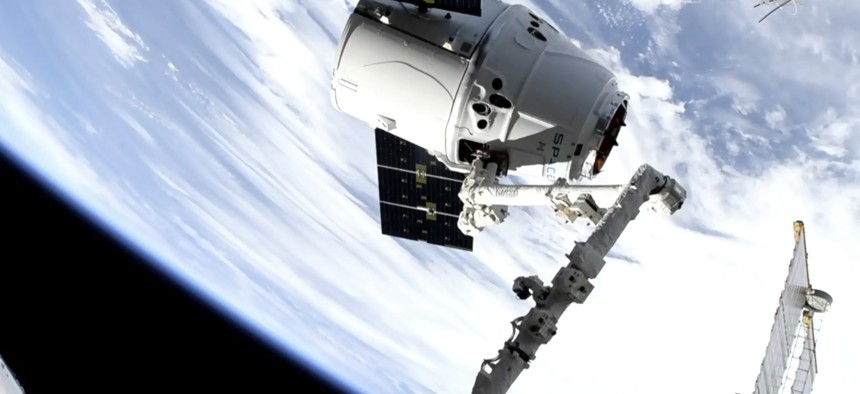
In this image taken from NASA Television, a SpaceX shipment arrives at the International Space Station following a weekend launch, Monday, May 6, 2019. The Dragon capsule reached the orbiting complex Monday, delivering 5,500 pounds (2,500 kilograms) NASA TV via AP
The Coming Flood of Space Junk Can’t Be Stopped by Technology Alone
Giant nets may help, but nations must solve the problem with new rules down here on Earth.
The number of manmade objects in orbit is set to triple in five years, a reflection of humanity’s growing dependence on ever-cheaper satellites for communication and imagery. Yet more spacecraft means more space debris to threaten them.
Technology can help. Sensors can track the larger pieces of orbiting junk, satellites can be built to dodge them, and giant nets may someday help collect cosmic litter, says Ambassador Sorin Ducaru, who directs the European Union Satellite Center. But what’s really needed, he said, are new international agreements governing how satellites are built and, eventually, degrade.
“This debris is already creating a huge problem because it's hard to address,” Ducaru said in a conversation at the GLOBSEC security conference in Bratislava, Slovakia.
The rapid increase in satellite launches is driven by 3-D printing, which is making rocket engines cheaper and lighter; space ride-share services like Spaceflight that let small companies and institutions pool resources; and other factors, says Dan Pilone, whose Element 84 software company helps businesses work with satellite data.
“From 2016 to 2107, small sat launches doubled. And they’re going to double again as we get into this year,” Pilone said. “Something like 7 percent of the tracked space objects are functional satellites. It’s an unbelievably small portion of what’s up there is useful.”
Much of that eventually falls back toward Earth, burning up in the atmosphere on the way. But the process can take months or years.
On top of that are anti-satellite missiles that blast enemy spacecraft into bits. The United States, Russia, and China all tested weapons that can blow up satellites more than a decade ago. In March, India joined the club with its own successful shoot down.
Emerging technologies to address the problem include satellites that harpoon orbital debris and even space nets, successfully tested last September by British researchers.
Ducaru said these solutions aren't practical for smaller debris traveling at higher velocities, which is much more common and likely to cause harm.
“Most of the objects are not so big, like a baseball, and have huge velocity,” he said. A baseball moving at three to seven kilometers per second “could significantly damage a functioning satellite.”
For expensive future satellites, that means a greater emphasis on spotting dangerous debris and moving out of its way.
“The only way to go is to get out of their trajectory, which means monitoring and then using fuels and stuff like this,” he said.
That’s becoming easier, thanks to advances in the ability to monitor objects in space. U.S. Air Force officials say their $1.5 billion Space Fence monitoring system will reach initial operating capability later this year.
Space Fence’s builder, Lockheed Martin, says its radar detected debris from the Indian anti-satellite missile launch in March.
It’s also becoming cheaper and easier to talk to satellites and help them move out of the way of debris, thanks to new communications services like the AWS Ground Station.
But ultimately, says Ducaru, the international community will have to do a better job governing how satellites are made and how they degrade after they are no-longer useful.
“The best scenario is to establish a regime whereby those assets we send to space, once they are approaching the end of their lifetime, there is some mechanism whereby they could be either collected or actually guided back toward the graveyard—it could be a spot in the ocean—and in a very controlled manner. Otherwise, if they’re blown up or if they collide, they create even more space debris.”
It might not even require drafting entirely new regulation so much as making sure existing international norms, such as the 1974 U.N. Convention on the Registration of Objects Launched into Outer Space are fully up-to-date, he said.
“It’s like collecting your trash. It should be civilized.”




